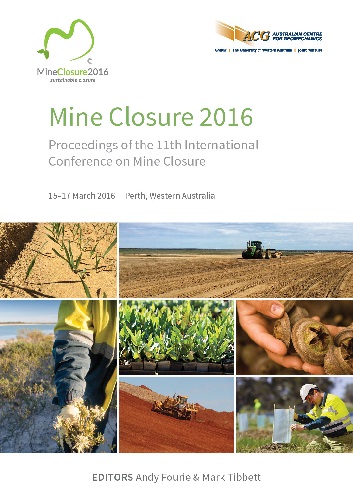Waste dump steep slope construction learnings

|
Authors: Moore, WT; Garneau, P Paper is not available for download Contact Us |
DOI https://doi.org/10.36487/ACG_rep/1608_02_Moore
Cite As:
Moore, WT & Garneau, P 2016, 'Waste dump steep slope construction learnings', in AB Fourie & M Tibbett (eds), Mine Closure 2016: Proceedings of the 11th International Conference on Mine Closure, Australian Centre for Geomechanics, Perth, pp. 75-88, https://doi.org/10.36487/ACG_rep/1608_02_Moore
Abstract:
Optimising and testing final waste dump batter slope parameters prior to reclamation is a valuable step within the mine closure planning process. The aim of the testing is to increase knowledge of site specific characteristics, verify performance against the closure criteria, and assist in revising what are often high level closure costs. Newmont Boddington Gold (Boddington) is owned and operated by Newmont Asia Pacific and is located approximately 130 km southeast of Perth in Western Australia. The operations consist of two large hard rock open pits, with a current mine life until 2029, with processing of stockpiled material until 2032. The expected final footprint of the waste rock dumps is 811 hectares. In late 2014, Boddington constructed a rehabilitation trial on an outer slope of Waste Rock Dump 7 (WRD07). The primary goals of the trial were to: i) construct and verify if a steeper than currently approved slope can remain safe and stable whilst meeting closure criteria, and ii) understand the water balance of the slope. Key variables tested within the trial include a 22 degree batter angle, and three surface treatments each with varying ratios of rock armouring within the two metre oxide cover. The same prescribed gravel and topsoil materials were applied to the three surface treatments. If the trial can demonstrate that a safe and stable slope can be constructed, expected benefits to mine closure planning and execution includes a reduction in dozer pushing costs, better designed surface water drainage system, and more accurate prediction of the volume of leachate that will be required to be managed. Assessment of the slope’s performance is monitored through water balance measurements, erosion assessment and vegetation growth assessment. Monitoring equipment installed within the trial includes a lysimeter, six soil sensory nests, and a runoff/interflow collection system. This paper presents a case study of the construction of the trial. The information obtained from the project will be highly valuable in assessing the current closure plans and performance against closure criteria.
Keywords: steep slope, trial, surface treatments, water balance, construction
References:
Anand, RR 1998, Regolith-Landform evolution and geochemical dispersion from the Boddington Gold Deposit, Western Australia, Cooperative Research Centre for Landscape Evolution and Mineral Exploration, November 1998.
McArthur, WM 2004, Reference soils of south-western Australia, Department of Agriculture, Western Australia.
Newmont Asia Pacific 2012, Newmont Boddington Gold Mine Closure Plan M70/21, M70/22, M70/23, M70/24, M70/25, M70/564, M70/799, M70/1031, ML264SA(1), ML264SA(2), G70/215, G70/218, G70/219, L70/28, L70/95, L70/96, Newmont Asia Pacific, Perth.
OES (Outback Ecology Services) 2013, Newmont Boddington Gold Rehabilitation Resources Inventory March 2013, OES, Perth.
SLR Consulting 2013, SLR Consulting Comparison of Erosional Performance of Two Alternative Slope Geometries and Optimisation of the Slope Profile to Minimise Erosion, SLR Consulting Australia, Perth.
© Copyright 2025, Australian Centre for Geomechanics (ACG), The University of Western Australia. All rights reserved.
View copyright/legal information
Please direct any queries or error reports to repository-acg@uwa.edu.au
View copyright/legal information
Please direct any queries or error reports to repository-acg@uwa.edu.au